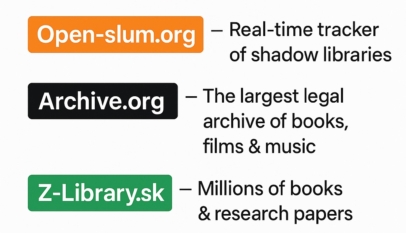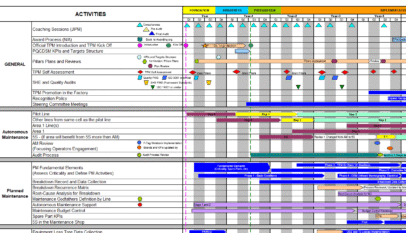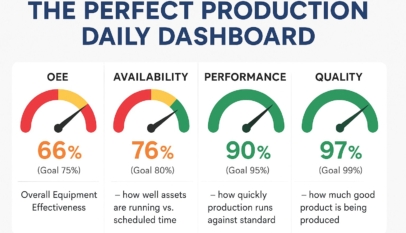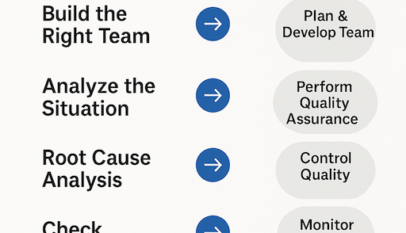In the world of project management, there are many misconceptions. Today, we’ll debunk some of them.
Myth #1: Change is Inherently Negative
Contrary to popular belief, change isn’t something to be feared. While finding solace in the familiar is natural, clinging to the status quo often hinders progress. Change, be it in technology, processes, or consumer behaviour, is an inevitable and constant element of our professional lives.
Consider the fate of giants like Smith Corona, RadioShack, Nokia, Sears, and Borders—their inability to adapt to change led to their downfall. In contrast, embracing change is a key driver of long-term organizational success.
Project managers (PMs) and business analysts (BAs) stand at the forefront of this evolution. They are the change management champions within an organization. Every project they spearhead introduces some degree of change. Skilled PMs and BAs not only facilitate these changes but also foster a culture that embraces and adapts to these shifts positively.
Remember, not all change leads to negative outcomes. It often opens doors to new opportunities and innovations. The expertise of professional project management turns these opportunities into successes.
Engaging with Change-Resistant Cultures
Have you ever encountered resistance to change in your workplace? How did it impact you and your projects? As PMs or BAs, have you faced pushback from key stakeholders? Share your strategies for overcoming this resistance and garnering support for change.
Myth #2: Project Management is Not Just for Big Projects
There is a common misconception that project management practices only apply to large-scale projects such as constructing skyscrapers, designing new cars or airplanes, or developing complex software systems. This belief, which is often repeated in discussions held by Project Management Offices (PMOs), fails to acknowledge the critical role of project management in smaller projects.
It’s crucial not to overlook project management in smaller-scale projects because doing so can lead to significant setbacks. Smaller projects often suffer from several issues, such as a lack of clear goals, poor management of schedules, ineffective team communication, an unhealthy team culture, insufficient budget and quality control, and weak scope and risk management. These oversights can transform a modest $10,000 project into a costly $30,000 endeavour, doubling the time and tripling the expenses.
For larger organizations, a $20,000 overrun might seem trivial. However, when these overruns accumulate across multiple small projects, the financial impact can be substantial. It’s an alarming fact that 1 in 7 IT projects, not necessarily large ones, fail to the extent of risking the organization’s very existence.
The next time you encounter the belief that project management is only for large projects, a few probing questions can quickly debunk this myth. Effective project management is indispensable, irrespective of the project’s scale.
Myth #3: The Customer is Always Right in Project Management
In the world of business, the saying “the customer is always right” is widely accepted. However, when it comes to project management, blindly following this adage can result in unwise decisions. While customer feedback is undoubtedly crucial, it’s essential to keep in mind that customers may not have all the information needed for the successful execution of a project. Therefore, it’s vital to approach customer feedback with a grain of salt and rely on professional expertise to make informed decisions.
Here are key reasons why this perspective needs reevaluation:
- Lack of Clarity: Customers often struggle to articulate their exact needs or desires.
- Knowledge Gaps: Customers may not fully comprehend the technical aspects or limitations of a project.
- Oversights: Customers might miss critical elements impacting the project’s outcome.
- Impractical Requests: Sometimes, what customers ask for may not be feasible or technically possible.
- Business Alignment: Customers may desire features that don’t align with the broader business objectives.
- Unfamiliar Benefits: They might be unaware of certain beneficial features or solutions that could enhance the project.
Accepting customer demands without scrutiny can lead project teams down problematic paths. As project leaders, our role extends beyond merely satisfying customer requests. It involves guiding them towards the most effective solutions. This can be achieved by:
- Setting Realistic Expectations: Clearly define what can be achieved within the project’s scope.
- Effective Communication: Maintain transparent communication throughout the project lifecycle.
- Inclusive Feedback Loops: Involve customers in retrospective sessions and continuous feedback mechanisms.
The next time you encounter the notion that “the customer is always right” in the context of project management, consider these points to provide a more nuanced and effective approach.
Myth #4: Extensive Experience Isn’t the Only Path to Project Management Success
It’s a common belief that only project managers with years of experience can achieve success. However, this isn’t necessarily true. While experience can be beneficial, it’s not the sole determinant of a project manager’s effectiveness.
I’ve observed experienced PMs struggle and novices excel. The key lies in how these professionals approach their development and adapt to the role. For those with less experience, there are numerous ways to build competence and confidence in project management:
- Podcast Learning: Tune into project management podcasts to stay updated with industry trends and insights.
- Mentorship: Seek guidance from an experienced PM who can provide mentorship and practical advice.
- Educational Investment: Consider enrolling in project management courses or degree programs for formal education.
- Self-Education: Read books, articles, and blogs dedicated to project management to broaden your understanding.
- Professional Development: Attend seminars, webinars, and workshops to learn from experts and network with peers.
- Networking: Join organizations like the Project Management Institute and engage with your local PMI chapter.
- Industry Events: Participate in events like the PMI Global Summit to gain insights and connect with fellow professionals.
- Certification: Start with an entry-level project management certification, which is a great learning process in itself.
- Leveraging Networks: Utilize your professional network for advice and solutions when facing challenges.
- Tool Familiarity: Use various project management applications to become adept with different tools and techniques.
The path to becoming a successful project manager is diverse and accessible. With a continuous learning mindset, active effort, and strong professional relationships, success in project management is well within reach, regardless of your experience level.
Myth #5: The True Value of Regular Project Meetings
The belief that frequent project meetings are inherently unproductive is a misconception that needs addressing. As a project manager, it’s crucial to demonstrate the value of these meetings to your team.
Regular meetings, be it weekly team gatherings or daily stand-ups, play a vital role in project management:
- Fostering Communication: They ensure continuous and clear communication within the team.
- Encouraging Collaboration: These sessions are key to team building and collaborative problem-solving.
- Risk and Opportunity Assessment: They provide a platform to discuss project risks, issues, and potential opportunities.
- Driving Accountability: Regular meetings encourage prompt action and accountability among team members.
- Addressing Roadblocks: They offer a chance to identify and plan for any obstacles or delays in project tasks.
- Soliciting Feedback: Meetings are an excellent opportunity for team members to express their views and align on the project’s direction.
Experience shows that projects lacking regular meetings often face challenges in managing key aspects like cost, schedule, and quality.
So, how can you ensure that these meetings are productive and valued by your team?
- Structured Agendas: Always have a clear agenda for each meeting.
- Mindful Scheduling: Be cautious about impromptu meetings and their frequency.
- Time Management: Start and end meetings punctually. Aim to finish early when possible, as this can positively impact team morale.
- Active Feedback: Regularly seek input from team members about meeting formats and content, and be open to adjustments while maintaining focus on project success.
Have you encountered skepticism regarding the efficacy of project meetings? Share your experiences and how you addressed them.
Myth #6: Are Constant Meetings Essential for Project Success?
Following our recent discussion on the misconception that constant meetings are unproductive, let’s explore another prevalent myth in project management: the belief that incessant meetings are indispensable for project success.
While regular meetings hold significant value in maintaining a project’s rhythm and ensuring team alignment, it’s crucial to strike a balance. Each meeting should be purposeful and add value to stakeholders. Excessive meetings, particularly those perceived as non-contributory, can lead to team frustration, resentment, and disengagement.
Seasoned project managers excel in finding the optimal frequency of meetings. They balance progress with the team’s need for information, ensuring that meetings are meaningful and focused. A key indicator of meeting efficacy is whether team members understand and see the value in these interactions. If they’re questioning the purpose, it’s a signal to reassess and realign.
Time management is especially critical in project environments. In scenarios where team members are juggling multiple initiatives, such as in non-agile, traditional project setups, it’s essential to keep them motivated and engaged. This requires skillful and considerate scheduling of meetings, always bearing in mind the team’s broader workload and commitments.
Have you encountered opinions or practices favouring constant meetings in project management? How did you address this perspective?

















